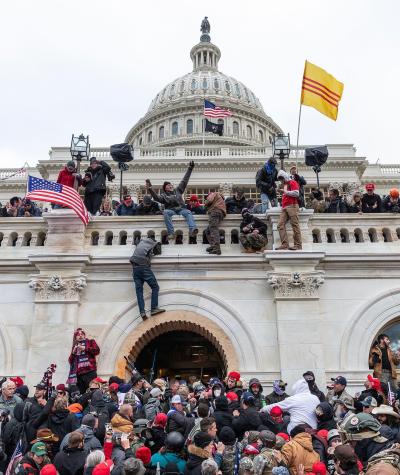The country watched in shock as a mob of Trump supporters breached Congress on Jan. 6, 2021, seeking to delay the inevitable certification of President Biden’s victory. A lot of the blame for this incident has correctly fallen to former President Trump. Since his presidency began, Trump has made false claims of voter fraud and illegal voting.
But the problem goes well beyond him, since 147 Republicans voted to overturn the duly certified results of the election. In the lead up to Election Day and the certification of the election results, elected Republicans questioned the results using increasingly inflammatory rhetoric.
Why have so many fallen in line with Trump’s rhetoric? A simple calculation: they know their biggest challenge to reelection will not come during a general election, but from a primary challenge because their districts have been intentionally drawn to ensure that a member of their party wins that district’s seat.
Fueling the reckless politics on display today is extreme gerrymandering. Thus, they substitute consensus-building within their districts so they can channel the passions of base voters that turn out in primaries.
For example, Rep. Scott Fitzgerald (R-Wis.), whose congressional district is part of a plan that is highly skewed in favor of Republicans and who was elected in the same election that Biden won the presidency, used one of his first votes in Congress to object to Biden’s victory.
Many representatives from gerrymandered plans supported “stop the steal”. State officials ignored the pleas of nonpartisan election administrators to allow for the counting of mail-in ballots before Election Day, which would have sped up the release of election results.
Rather than grant the request, Republican officials in Pennsylvania, Michigan, and Wisconsin (with extremely gerrymandered state legislatures) suggested that the time the election administrators needed after Election Day to count ballots was evidence of fraud. Lack of accountability for fanning the flames of these conspiracy theories comes from polarization, which gerrymandering exacerbates.
The process of creating gerrymandered seats begins with the census, which counts all people living in the U.S. in years ending in zero. That is, 2010, 2020, and so on. Once this task is completed, the data is then given to states to draw new lines for districts for Congress and state legislatures. In most states, the governor and legislature are responsible for drawing these new districts.
In 2010, the Republican Party deployed a strategy called REDMAP that helped them take unilateral control of the redistricting process in 20 states. These maps were used nationwide between 2011 and 2020. Unsurprisingly, when one party has unilateral control over map drawing, they make every effort to draw maps shielding them from facing competitive reelection races.
Beginning in 2015, Campaign Legal Center represented Wisconsin voters in a case challenging the state’s extreme gerrymander. Maps were drawn behind locked doors in law firm offices rather than at the state capitol, and there was no opportunity for public input. Notably, former Gov. Scott Fitzgerald was one of the few map drawers, so he won a seat in Congress under the map he engineered.
The U.S. Supreme Court ultimately refused to strike the maps down as unconstitutional, and so gerrymanders like Wisconsin’s stand strong and will likely be fortified—if legislators retain unified control of the redistricting process—in the coming decade.
Thankfully, in some of the states with the most egregious gerrymanders, citizens are taking power back. Voters in states across the country have been fighting for democracy reform.
In 2018, voters in Colorado, Michigan, Missouri, Ohio, and Utah approved redistricting reforms designed to take the partisan interests of legislators out of the process. Sadly, the changes in Utah and Missouri were later rolled back, but in 2020, Virginia voters approved a reform.
The reform adopted in Michigan created an independent redistricting commission (IRC), taking the power entirely out of the hands of the normal legislative process.
Over 9,000 Michiganders applied to be one of the 13 commissioners. These four Democrats, four Republicans, and five Independents have now begun the map drawing process that includes having at least 15 public hearings between now and August.
Congress also has the chance to pass the For the People Act, which includes requiring IRCs for Congressional elections.
These and other redistricting reforms in states like Alaska are aimed at giving politicians the space needed to represent a larger swath of their constituencies. They may already be having an effect. Two of the seven Michigan Republican Congressmembers voted to impeach Trump.
Politicians have a choice: they can support reforms that lead to a more perfect union or continue to focus on a small subset of voters.
With the National Guard surrounding the Capitol to ensure the safety of our democracy and Congressmembers receiving death threats, the consequences of the wrong decision are dire.
